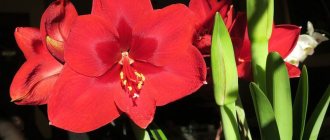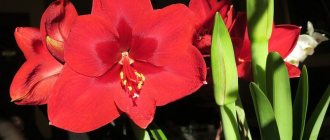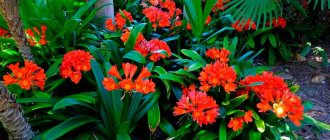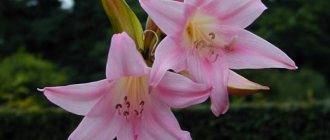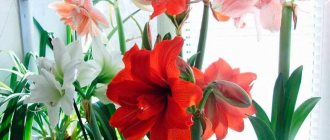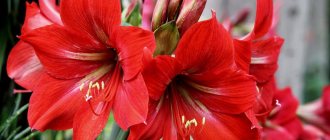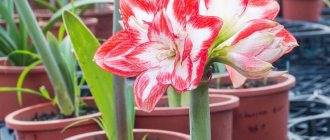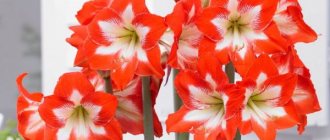Author: Elena N. https://floristics.info/ru/index.php?option=com_contact&view=contact&id=19 Category: Houseplants Published: June 27, 2012Republished: February 27, 2019Last edits: March 19, 2021
If you have both flowers in front of you, then it is not difficult to distinguish amaryllis from hippeastrum. It's harder to confuse them. A mistake can be made by buying a bulb or plant without flowers. For those who are not aware of the difference between these colors, we suggest using the following tips.
Amaryllis
Amaryllis belongs to the amaryllis family and is quite common in South Africa. It is also called:
- belladonna lily;
- Jersey lily;
- amarillo;
- March lily;
- naked lady
From Greek, the name of the flower is literally translated as “to sparkle . In nature, you can find only one type of amaryllis - Belladonna.
The plant is poisonous and grows only in the Karoo Desert. All other types of amaryllis were bred artificially. Belladonna flowers are slightly smaller than those of other breeding varieties and are light pink in color.
The plant has green leaves up to 50 cm long and 2-3 cm wide, which are arranged in two rows. This flower does not like frost, and at the same time does not tolerate tropical conditions. The optimal temperature for it is +18…+25 degrees. The plant begins to bloom in late summer or late spring.
From the seeds of the plant, 1-2 stems appear, on which from two to twelve flowers of six petals are located. The height of amaryllis itself is up to 60 cm. Flowers can be white, red, pink or purple with veins. Most often, this flower grows in dense clusters, which is due to the large weight of large seeds.
Interesting! Amaryllis is the name of a beautiful shepherdess from the idylls of the poet Theocritus, which were written more than two thousand years ago.
We offer a visual video about the amaryllis flower:
You can learn about the appearance and structure of amaryllis here.
Who cares?
The differences between these plants can be presented in a summary table:
| differences | Amaryllis | Hippeastrum |
| Differences between types | It belongs to the genus Amaryllis and is defined by only one type, Amaryllis belladonna. | It belongs to the genus Hippeastrum. So far, there are about 90 species of this plant. |
| Differences in origin | Plants native to southern Africa. | It comes from the tropics and subtropics of America. |
| Differences in appearance | This is an onion plant; the size of the bulb can reach 6-10 centimeters in diameter. Green Leaves Leaves are absent during flowering. The inflorescences of this plant form 2-12 flowers, the size of which is approximately 7-10 centimeters in diameter, the flowers consist of 6 petals. The flowers are white, red, pink and purple. The stem of this plant is fleshy. | The tuberous plant, its bulb, is a turnip measuring 5-10 centimeters in size. The leaves of the plant are long green, their size and shape, and the shade depends entirely on the species. During flowering, this plant's inflorescences can form from 2 to 5 flowers with a diameter of 15-25 centimeters. Flowers have 6 petals. This plant, depending on the subspecies, has many flowers of any shade. |
| Difference in growth and flowering | Amaryllis takes about 56 days to grow from seed. At home, flowering occurs in the fall, and the rest of the time the flower rests. | Grows from seeds in two weeks. Flowering begins in winter and can last until spring. |
| Differences in home care | It does not require special care. This flower does not like excessive humidity because it can cause fungal diseases. Before flowering, this plant must be at rest. To do this, place them in a dark place in the summer. | This flower is not capricious. He does not like frequent watering. To get good blooms within a month, you must calm the plant by placing it in a dark place. |
Attention! Both plants are susceptible to fungal diseases. To avoid this, good soil drainage and regular moisture monitoring are necessary.
Hippeastrum
Hippeastrum is also a member of the amaryllis family . In nature, this flower can be found in tropical and subtropical areas of America, including the Amazon basin. Just like amaryllis, hippeastrum grows up to 60-80 cm in length and has 2-6 flowers.
Up to three peduncles can grow from one flower bulb. The color of flowers can be very different - purple, orange, white, pink. The flowers themselves are quite large - their length can reach 25 cm. The flowering period of hippeastrum is spring (March-April). If the plant is grown at home, flowering can occur at any time of the year.
With proper care, hippeastrum can live 15-20 years , and flowering will be annual. If the conditions are very comfortable, the bulb may produce a second flowering arrow.
After much debate, scientists have developed a classification of hippeastrums, which is based on the origin, timing of flowering, size and shape of the flower. The classification includes hybrids:
- with Ammaralis belladonna;
- with double flowers;
- with long-tube flowers;
- miniature-flowered;
- with hippeastrum Regina;
- Leopold hybrids;
- with orchid flowers.
In addition, there are wild species that are actively cultivated and varieties that are not included in the previous groups.
More information in the video about hippeastrum:
Reviews
Several differences between hippeastrum and amaryllis. If the peduncle is hollow, then it is hippeastrum. If the peduncle is not hollow, then it is amaryllis. Children of hippeastrum and amaryllis are formed differently. In hippeastrum, babies usually appear near the drying scales on the outside of the bulb. In amaryllis bulbs, babies appear between the scales inside the bulb, which is why the amaryllis bulb has several growth points. The flowering period for hippeastrum occurs at the end of autumn, winter and spring, for amaryllis - in autumn. Hippeastrum grows and blooms well when grown indoors. It is more difficult for amaryllis to grow and bloom in an apartment, because during the period of active growth after flowering in the conditions of our apartments in winter and spring, amaryllis clearly does not have enough light.
Svyatoslav
https://frauflora.ru/viewtopic.php?p=77507#p77507
Why are they often confused?
These two flowers are quite often confused. This is due to the fact that they are really similar in many factors. Both plants have flowers located on a high stem, where they bloom. Besides this, the inflorescences are quite similar to each other. Both amaryllis and hippeastrum reproduce using :
- bulbs;
- seeds;
- scales;
- kids.
Origin of plants
Flower hippeastrum red, white, grand diva and others
These flowers grow in completely different regions of the planet. The genus Hippeastrum is found in America, in the subtropical and tropical zones, most of it is found in Peru, Brazil and Bolivia in the Amazon basin. This genus is considered a geophyte and grows mostly in steppe and mountain-steppe regions. Amaryllis were found in South Africa and later brought to Australia. They are mesophytes and prefer sufficiently moist soils.
What is the difference: information and photos
Despite the fact that these plants belong to the same genus Amaryllis, they have many special characteristics. It is not difficult to find the differences between amaryllis and hippeastrum if you pay attention to the photos below and the “Differences” table.
| Differences | Amaryllis | Hippeastrum |
| Genus | Has only 1 type. | There are more than 90 species. |
| Origin | Brought from Africa. | Artificially produced. |
| Appearance | The bulbs look like a pear, smooth. Daughter bulbs can often be seen. | The bulbs are slightly elongated, round, scaly. There are almost never daughter bulbs. |
| Care | Tolerates cold well. | Does not tolerate low temperatures. |
| Growth and flowering | It can be grown both in the garden and on the windowsill. Seeds germinate in 8 weeks. During flowering, which occurs only once a year, there are no leaves on the stem. A pleasant aroma emanates from the inflorescences. | It can only be grown on a windowsill, on the south side. Seed germination is observed after 2 weeks. The plant blooms several times a year. Flowers have virtually no scent. |
You can find out about the reasons for the lack of flowering and how to stimulate the appearance of buds here.
In the photo there is an amaryllis flower:
And this is hippeastrum:
1.Seven secrets of success:
| 1. Growing temperature: in summer – fairly warm content at a temperature of 21 to 24° C, winter – cool dormant period at 13° C. |
| 2. Lighting: with the appearance of the first shoots, the plant is placed in a brightly lit place without direct sunlight. |
| 3. Watering and air humidity: during the period of growth and flowering, the substrate should be well moistened; as the leaves die, watering is reduced and the bulbs are stored in almost dry soil. Air humidity does not need to be increased. |
| 4. Features: do not immediately remove drooping leaves - they continue to feed the bulb. |
| 5. Soil: Should have excellent drainage, amaryllis can be grown in fairly nutrient-poor soil. |
| 6. Feeding: feed only during the period of growth and flowering; during the dormant period, feeding is excluded. |
| 7. Reproduction: often by daughter bulbs, less often by seeds. |
Botanical name: Amaryllis.
Amaryllis domestica - family
Homeland of the plant. The plant originates from the tropical regions of South Africa.
Features of home care
Both of these flowers are unpretentious . They are grown in small pots and replanted every 3-4 years. Both amaryllis and hippeastrum do not like too much watering, which can lead to rotting and subsequent death of the bulb. Both of these plants are heat-loving - their pots should be placed on the south side, but they should not be exposed to direct sunlight.
Reference! After the plant has flowered and begins to enter the dormant phase, it must be gradually weaned off watering and the leaves must be cut off. While in the resting phase, both amaryllis and hippeastrum do not require care.
Read about how to care for amaryllis at home so that the flower pleases you with its beauty.
We have other interesting materials about amaryllis: about plant diseases, about winter care, about flower bouquets, as well as about growing amaryllis indoors and outdoors.
The history of appearance in Europe and what makes flowers similar
Europe discovered new indoor flowers only late, and was first mentioned in professional plant catalogs in 1737, originally called lilies and lion daffodils. The described genus Amaryllis is based on the description of the first specimens brought from South Africa. Later, new specimens brought from the subtropics of America began to be classified as the same species.
In 1821, botanist W. Herbert identified the main differences between Amaryllis from Africa and plants from the American regions. The new genus was named Hippeastrum. At the same time, Amaryllis beautiful is the true and only species; all other varieties and hybrids are called Hippeastrum or Hippeastrum hybrid. This order was established only in 1954 by the International Botanical Congress.
In the middle of the 19th century, amaryllis were reported to be delivered to St. Petersburg. In 1936, a nursery for growing bulbs was organized in Adler, and in Estonia, breeding work has been carried out at the Institute of Experimental Biology since 1953.
Hippeastrum and amaryllis are bulbous plants. They reproduce by seeds, pups and scales from the bulb. After a period of dormancy, an arrow topped with large gramophones grows from the bulb. After prolonged flowering, a period of dormancy begins.
The shapes and colors of varietal and hybrid specimens are varied. For lovers, both flowers are perfect in beauty and are the pride of the owner.
How to distinguish: easy, simple ways
There are several ways to distinguish these two plants:
- Look closely at the leaves. Amaryllis leaves are narrow and smooth, with a groove. Hippeastrum has wide, tough foliage.
- Number of flowers. On amaryllis you can count 6-12 flowers, and on hippeastrum - 2-6.
- Flowering period. Amaryllis blooms for 30-40 days, and hippeastrum for two months.
- Stem. The stem of the Belladonna lily is fleshy and full, while that of the Hippeastrum is hollow inside.
- Amaryllis is quite difficult to find; it is often grown by collectors. Hippeastrum is more common.
- Hippeastrums can be of almost any color - the number of shades reaches two thousand.
As you can see, in fact, amaryllis and hippeastrum have quite a lot of differences. Knowing how these plants look and bloom, you can easily distinguish them from each other and grow exactly the type that you need.
Characteristics table
| Feature name | Amaryllis | Hippeastrum |
| Number of species in the genus | 1 | 90 |
| Onion shape | Pear-shaped | Round, slightly elongated |
| Leaf Shape | Narrow | Wide, belt-like |
| Presence of leaves during flowering period | No | Eat |
| Number of blooms in 12 months | 1 | Some |
| Flowering period | Autumn | Winter |
| Number of flowers on a peduncle | 6-12 | 2-5 |
| Color spectrum | Limited | Extensive |
| Aroma | Present | Absent |
Amaryllis is a rare guest among indoor flowers. Most gardeners keep bright hippeastrums at home. It is impossible to say which of the overseas wonders is better, because both are worthy representatives of tropical plants.
